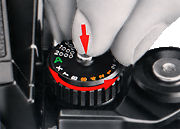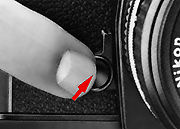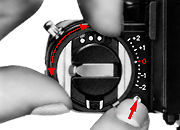An theoretical ideal exposure requires proper combination of shutter speed and opening of the lens' diaphragm. Both elements control the amount of light reaching a film. A camera body, which houses a shutter with the ability to varying the duration of the shutter curtain opening by way of adjustment in shutter speeds control. All SLR cameras has a conventional shutter speed dial either a top or around the lens mount to allow a photographer to fine tune shutter speed selection.
Most camera manufacturers designed their SLR camera with the shutter speed dial as the main command center to control other camera functions.
 |
The Nikon F3 has 18 manual shutter speed settings ranging from 1/2000 sec to a full 8 sec and 'B' (Bulb), 'T' (Time exposure) and 'X' (Sync speed at 1/80 sec). The green 'A' is for automatic exposure. |
Since the primary function of the camera body is for controlling duration of the shutter curtain opening, other functions are essentially supplementing what you have on the shutter speed dial. For example, AE lock button or exposure compensation dial is for fine tuning the 'A' (AUTO) exposure control, Backup mechanical lever is life saving feature in an important assignment in case the battery fails to function normally etc... But since the Nikon F3 is a system camera and have a modular design concept, many 'parts' of the camera can be detached and fitted with other dedicated designed accessories to suit one's desire and preference of how a camera should be.
The subsequent sections outlining various Controls In Detail is to illustrate how these functions can assist you in a more productive and creative photography.
In addition to automatic stepless* shutter speed control, the Nikon F3 High-Eyepoint camera offers manual control of all shutter speeds from 1/2000 sec. to 8 sec. including X, B, and T.
 |
 |
To move the shutter speed dial off green "A", depress the Shutter Speed Dial locking button as you rotate the dial counterclockwise to the 1/2000 sec. setting. |
You can then rotate the dial freely between any setting except "X" which, like "A," is a locked setting. Shutter speeds from 1/2000 sec. to 1/2 sec. are engraved in white, 1 to 8 seconds in orange, and "B", "T" and "X" in white. 1/60 sec. is in red, indicating the highest manual shutter speed for proper synchronization with electronic flash except "X".
* When you are in automatic exposure 'A' mode, All shutter speeds proved are stepless - meaning even if the LCD panel has shown with a speed of '125' (1/125 sec) or '30' (1/30 sec), the actually speed could be 1/108 sec. or 1/26 sec. In this case, all speeds are governed by a highly precise 256 Hz quartz oscillator.
To obtain correct exposure, simply turn the shutter speed dial and/or aperture ring until the "- + " symbol appears. |
|
When the camera is
on manual, an "M" appears to the left of the liquid crystal shutter speed
display inside the viewfinder. In addition, above the "M," the following
symbols appear: '-', '+' and '- +'
indicating underexposure, overexposure and correct exposure, respectively.
The F3 High-Eyepoint camera has two separate settings for time exposures. On "B," the shutter remains open for as long as the shutter release button is depressed. On "T," the shutter stays open until the dial is rotated to another setting, making it ideal for really long time exposures.
 |
Being a mechanical setting, "T" will not cause battery drain regardless of how long the shutter remains open. |
Note: Among all settings available on the shutter speed dial, the ONLY mechanical setting is 'T' (Time exposure). It doesn't draw battery power from the camera and thus it is a perfect setting for extended time exposure photography. The shutter curtain will remain open until you move the setting away to either direction of 'X' or 'B'. However, even if this is a mechanical setting, in the case of battery failure or situation where without any battery(ies) installed in the camera, you would still required to use the Backup Mechanical Shutter Release lever to activate the operation.
"X" provides a shutter speed setting of 1/80 sec. It is used to provide proper synchronization with electronic flash units other than the Nikon dedicated flash units such as SB- 12, SB-16A or SB-17 etc.
 |
The maximum permissible sync shutter speed remains the same at 1/80 sec. You might be wondering why F3's sync speed is so 'slow' at 1/80 sec. |
This is due to the shutter curtain design was a horizontal traveled curtain which has a longer traveling time than vertical in a 24mm x 36mm film format. Anyway, just for comparison, four professional camera models during the '80, Pentax LX's was 1/75 sec, Canon's New F-1 was marginally higher at 1/90 sec and Contax RTS II's 1/60 sec versus Nikon F3's 1/80 sec. - ALL these four top models share some similarity where all of them are employing a tough horizontal traveled titanium foil shutter curtain design and the highest sync speed were below 1/90 sec.
The
amount of light reaching the film plane is determined by a combination of the shutter
speed and the lens aperture. Since the two are interrelated, different combinations
will give the same degree of exposure. A one-step change in shutter speed, or a one-stop
change in aperture setting, will either halve or double the degree of exposure. For
example, a shutter speed of •1/125 sec. lets in twice as much light as a setting
of 1/250 sec., and only half as much light at 1/60 sec. For an aperture setting of
f/ll, twice as much light as f/16 and half as much as f/8, is let in. Thus, if the
correct exposure for a particular picture-taking situation is 1/125 at f/11, then
1/60 at f/16 or 1/250 at f/8 will give the same exposure.
The following table illustrates the interrelation between shutter speed and aperture.
| Shutter Speed (Sec.) | 1/1000 | 1/500 | 1/250 | 1/125 | 1/60 |
| Aperture Value | 4 | 5.6 | 8 | 11 | 16 |
The best combination will depend on the results you want. Use fast shutter speeds to freeze motion; use slow speeds to produce a deliberate blur. (See the example pictures on the opposite page.). Also, small apertures give greater depth of field, while large apertures restrict sharp focus to the main subject.
A good rule to follow in preventing camera shake is to select a minimum shutter speed which is the reciprocal of the focal length of the lens in use. For example, when using a normal 50mm lens, select a speed no slower than 1/60 sec. (the closest number to 1/50). For a 500mm super-telephoto, use no less than 1/500 sec., and so forth.
* To make a mechanical release, turn the power switch off and make sure the LCD inside the finder is not displayed. Then, trip the shutter using the backup mechanical/ release lever. Note: IF you are using the shutter release button to trip the shutter - the camera will still draw battery from the camera even if you are turning the shutter dial to "T" setting.
Exposure memory lock button
When there is a substantial difference between the main subject and the background, unimportant bright spots or dark spots are likely to fool the camera's metering, resulting in underexposure or overexposure (see Fig. 1). One way to make exposure compensation is to use the memory lock. This control allows you to lock in an exposure reading with the camera on automatic control.
 |
To compensate for an excessively bright or dark background, center the main subject in the viewfinder or move in close to the subject, depress the memory lock button and hold it in; then recompose and shoot. |
Another way to correct exposure is to use this dial. Push the locking button while rotating the dial. The dial is graduated in one-third stop increments. -1 and - 2 indicate one and two stops underexposure, whereas + 1 and + 2 indicate one and two stops overexposure.
 |
At ASA/ISO 6400, the compensation extends to only T 1; at ASA/ISO 12, up to + 1. The following table indicates the recommended settings for various subjects. After use, make sure you set the dial back to "0" |
|
Original / Type of Film |
Repro Copying & Slide Copying |
Photo Macrography |
||
|
B&W / color photo |
Letters or figures on light background |
Letters or figures on dark background |
||
|
Panchromatic Film for general use |
No compensation is necessary |
+ 1 1/2 Stop |
- 1/2 Stop |
+ 1 Stop |
ASA/ISO film speed dial
The scale on the ASA/ISO dial has numbered settings for speeds from ASA/ISO 12 to 6400. Two dots between each pair of ASA/ISO numbers stand for intermediate settings, such as 64, 80, etc. The table below gives the speeds for all intermediate settings.
 |
|
ASA/ISO is a numerical rating of the film's sensitivity to a given amount of light. The higher the number, the greater the sensitivity, and vice versa. The ASA/ISO of your film is indicated on the cartridge itself. It is also printed on the film carton and on the data sheet packed inside.
|
| | | Back to Index of Nikon F3 Models Back to Pictorial History of Nikon SLRs |
|
|||||
|
|||||||
| Back |
Index Page of F3 Camera Manual
| Back |
Main Index Page of Nikon F3 models
| About this photographic site | Contributions and Credits |
 |
Home - Photography in Malaysia |